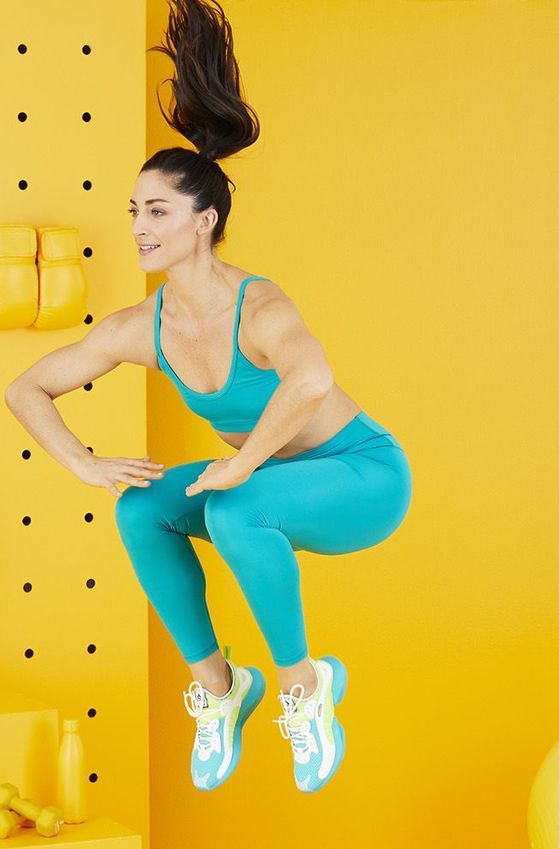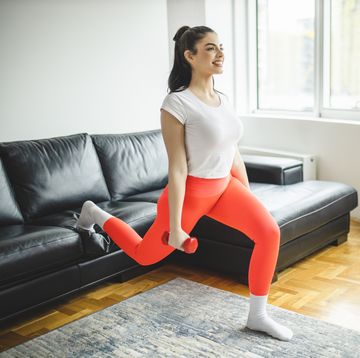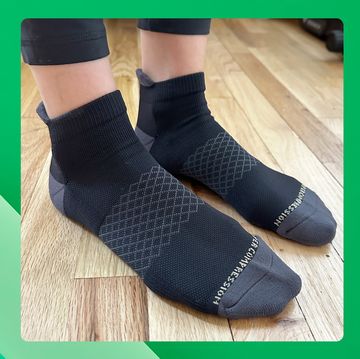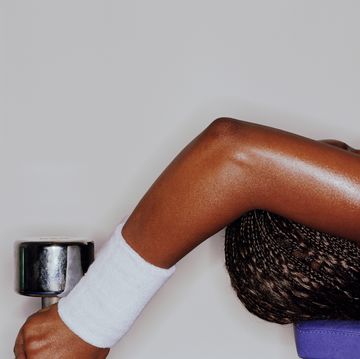Looking to spice up your workout with something that will a) challenge you and b) burn major calories? The tuck jump is where it's at. As a plyometric exercise, a tuck jump requires you to use your bodyweight and power to contract and engage several muscles at once to jump up in the air.
This move burns serious calories and will strengthen both your upper and lower body. I love adding this move to my plyometric circuits. It's a great exercise that will get both cardio and muscle toning in at the same time.
But you do have to be careful. If you’re not doing your tuck jumps the right way, you can cause added strain on your knees and joints. So before you start jumping, here's everything you need to know about the tuck jump: how to do it, benefits, modifications and more.
How To Do Tuck Jumps
- Start in standing position with feet hip-width apart.
- Bend knees slightly and extend arms out at shoulder height, elbows bent and wide, palms facing floor.
- Jump straight up, lifting knees to touch hands.
- Land softly with knees bent.
Pro tip: This is not meant to be a butt kick. So make sure you're jumping with knees tucked and your body shooting upwards toward your hands, rather than aiming backward towards your butt. To do this, engage your lower abs to help drive your knees up.
Reps/sets for best results: 5-10 reps with 30 seconds of rest in between
Benefits Of Tuck Jumps
A proper tuck jump will work your legs, core, glutes, and quads, giving you both the upper- and lower-body-strengthening exercise you want. And because jumping is involved, you'll also be able to sneak in some cardio with this move. Your heart rate will increase as soon as you begin, making sure that the necessary blood flow is reaching those targeted muscles groups.
How Your Muscles Work During A Tuck Jump
- Glutes and quads: These muscle groups act as a sort of spring during a tuck jump. They'll be contracting each time you explode upward and when you lower your hips down into that final landing squat.
- Calves: You can think of your calves as a personal assistant to both of the muscles above. They'll also help extend your ankles to get your feet off the floor during the jump. In order to absorb the shock of the landing and protect your main joints, try to land softly.
- Core: The tuck jump is just as much about the abs as it is the legs. If you're doing the move correctly, your lower abs will be engaged each time you bend down into the jumping position and as you propel upwards. Plus, your core is responsible for stabilizing and supporting your spine.
How To Avoid Injury During Tuck Jumps
If you have a knee, ankle, back or hip problem, you're going to want to skip the tuck jumps altogether. As with many jump exercises, this an explosive movement—and when you land on the ground, these four areas of the body absorb the impact.
The best way to avoid injury if you are doing the movement is to do a proper warmup. You want to focus on movements that encourage a full range of motion through the hips, knees, and ankles. Doing several bodyweight squats would be the perfect exercise to do as a warmup. From there, I'd suggest some alternating knee lifts, to continue working on hip mobility, and then light squat jumps just to practice landing mechanics—landing softly through the feet, knees, and hips.
Add Tuck Jumps To Your Workout
- Do it as a finisher: I don't recommend doing a tuck jump anywhere close to the beginning of a workout. You're not warmed up enough and can risk injury. But adding the tuck jump to the end of a workout can be great. It will give your training session a metabolic boost and ensure that you end your workout strong.
- Add it to your circuit: If you're doing a circuit with plyometric moves, I definitely recommend adding in a tuck jump. Maybe you'll do mountain climbers, tuck jumps and squat thrusts, doing each move for 30 seconds to a minute, with a minute rest in between. This will create an intense total-body cardio workout, and your muscles will be challenged to reach their fullest (and most tired...whew!) potential.
How To Modify Tuck Jumps
- Squat in between reps: If you start doing the tuck jumps and find that doing one tuck jump after another isn't so great for your knees or endurance, don't do them consecutively. Instead, scale it back a bit and do a squat, then a tuck jump, and then take a few seconds to reset before repeating.
- Break the move up into two: Another low-impact version of this move would be do a squat to knee drive, lifting one knee up at a time to reach your extended arms, instead of a full tuck jump. You're basically just separating the tuck jump into its two separate movements, which will reduce the risk of knee injury and put less pressure on your lower body overall.
Variations Of Tuck Jumps
Squat Jump
Start in a standing position with feet shoulder width apart, toes pointed forward, and weight in heels. Lower down into a squat, and then drive through heels to reverse movement and jump up as high as possible. Land softly back into the squat position. That's one rep. Complete as many reps as possible in 20 seconds at maximum effort, followed by 10 seconds of rest. Repeat eight times.
Alternating Jump Lunge
Start in a lunge position. Jump up and switch legs to land in a lunge on opposite side, keeping knees soft. Move arms for added momentum while switching legs. That's one rep. Repeat for 4 sets of 20 reps.
Kara Liotta, co-founder of KKSWEAT (a digital platform for live and on-demand boutique fitness classes), is a powerhouse celebrity trainer, master instructor, and fitness model based in NYC. As the former VP of Talent Development, Product Innovation, and Creative Director for Flywheel Sports, Kara was influential in the growth, expansion and success of the brand’s popular FlyBarre, FlyFIT and FlyRecover programs. She is a NASM-certified personal trainer, pre/post-natal training specialist and 200-hour vinyasa yoga instructor.
















